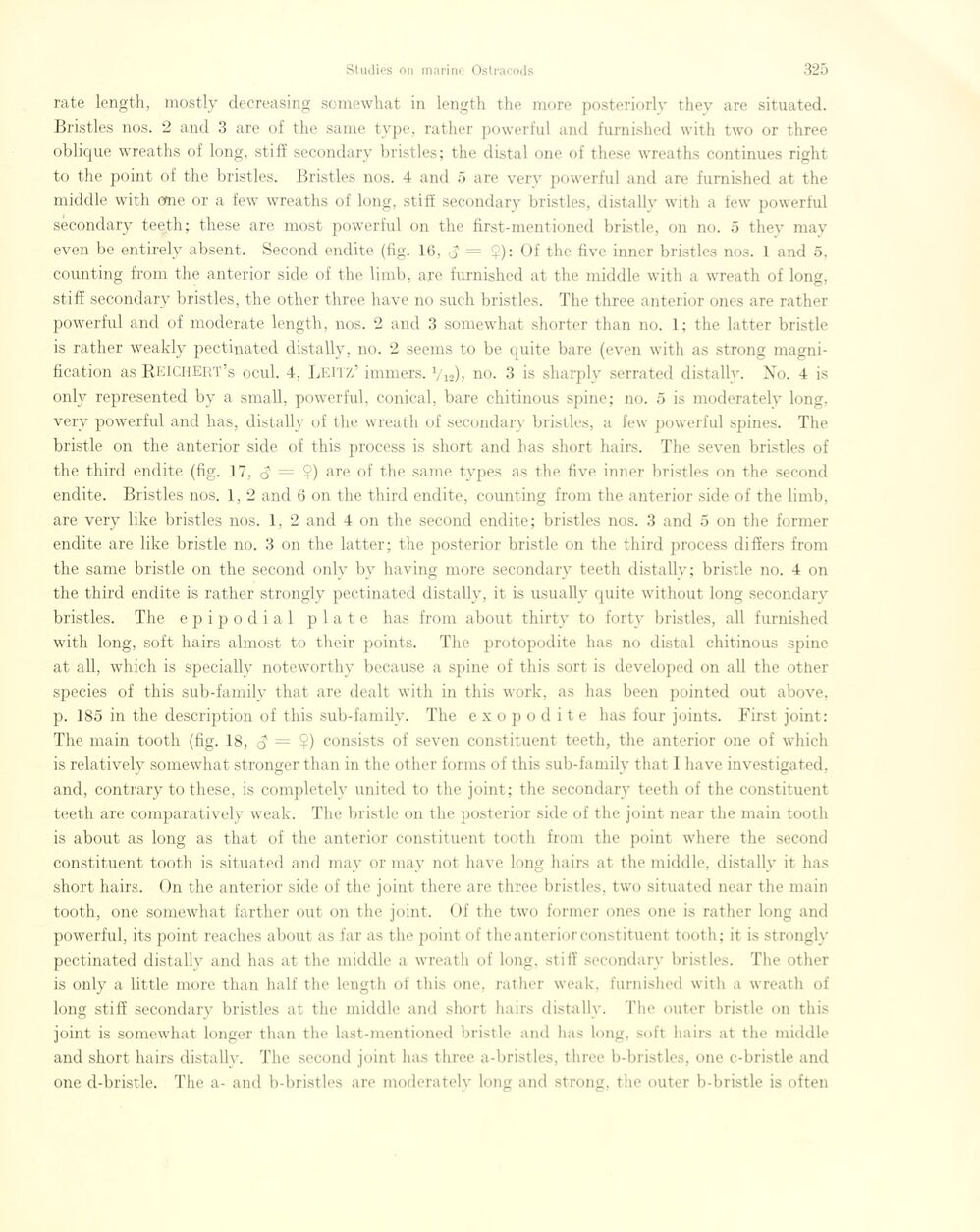
Full resolution (JPEG) - On this page / på denna sida - Sidor ...

<< prev. page << föreg. sida << >> nästa sida >> next page >>
Below is the raw OCR text
from the above scanned image.
Do you see an error? Proofread the page now!
Här nedan syns maskintolkade texten från faksimilbilden ovan.
Ser du något fel? Korrekturläs sidan nu!
This page has never been proofread. / Denna sida har aldrig korrekturlästs.
rate length, mostly decreasing somewhat in length the more posteriorly they are situated.
Bristles nos. 2 and 3 are of the same type, ratlier powerful and furnished with two or three
oblicjiie wreaths of long, stiff secondary bristles; the distal one of these wreaths continues right
to the point of the bristles. Bristles nos. 4 and 5 are very powerful and are furnished at the
middle with one or a few wreaths of long, stiff secondary bristles, distally with a few powerful
sécondary teeth; these are most powerful on the first-mentioned bristle, on no. 5 they may
even be entirely absent. Second endite (fig. 16, = Ç): Of the five inner bristles nos. 1 and 5,
counting from the anterior side of the limb, are furnished at the middle with a wreath of long,
stiff secondary bristles, the other three have no such bristles. The three anterior ones are rather
powerful and of moderate length, nos. 2 and 3 somewhat shorter than no. 1; the latter bristle
is rather weakly pectinated distally, no. 2 seems to be quite bare (even with as strong
magni-fication as Reichert’s ocul. 4, LeiTZ’ immers. V12), no. 3 is sharplv serrated distally. Xo. 4 is
only represented by a small, powerful, conical, bare chitinous spine; no. 5 is moderately long,
very powerful and has, distally of the wreath of secondary bristles, a few powerful spines. The
bristle on the anterior side of this process is short and has short hairs. The seven bristles of
the third endite (fig. 17, 3 — $) are of the same types as the five inner bristles on the second
endite. Bristles nos. 1, 2 and 6 on the third endite, counting from the anterior side of the limb,
are very like bristles nos. 1, 2 and 4 on the second endite; bristles nos. 3 and 5 on the former
endite are like bristle no. 3 on the latter; the posterior bristle on the third process differs from
the same bristle on the second only by having more secondary teeth distally; bristle no. 4 on
the third endite is rather strongly pectinated distally, it is usually quite without long secondary
bristles. The epipodial plate has from about thirty to forty bristles, all furnished
with long, soft hairs almost to their points. The protopodite lias no distal chitinous spine
at all, which is specially noteworthy because a spine of this sort is developed on ail the other
species of this sub-family that are dealt with in this work, as has been pointed out above,
p. 185 in the description of this sub-family. The exopodite lias four joints. First joint:
The main tooth (fig. 18, 3 = $) consists of seven constituent teeth, the anterior one of which
is relatively somewhat stronger than in the other forms of this sub-family that I have investigated,
and, contrary to these, is completely united to the joint; the secondary teeth of the constituent
teeth are comparatively weak. The bristle on the posterior side of the joint near the main tooth
is about as long as that of the anterior constituent tooth from the point where the second
constituent tooth is situated and may or may not have long hairs at the middle, distally it has
short hairs. On the anterior side of the joint there are three bristles, two situated near the main
tooth, one somewhat farther out on the joint. Of the two former ones one is rather long and
powerful, its point reaches about as far as the point of the anterior constituent tooth; it is strongly
pectinated distally and has at the middle a wreath of long, stiff secondary brist les. The other
is only a little more than half the length of this one, rather weak. furnished with a wreath of
long stiff secondary bristles at the middle and short hairs distally. The outer bristle on this
joint is somewhat longer than the last-mentioned bristle and lias long, soft hairs at the middle
and short hairs distally. The second joint has three a-bristles, three b-bristles, one c-bristle and
one d-bristle. The a- and b-bristles are moderatelv long and strong, the outer b-bristle is often
<< prev. page << föreg. sida << >> nästa sida >> next page >>